With so many amazing places to see in Spain determining an itinerary can be a real challenge. With the help of some friends, we put together this list of 17 of Spain’s World Heritage sites to give you a bit of a starting point. If it makes a UNESCO list, it’s got to have something going for it 🙂
This post may contain affiliate links. If you book via these links, we may make a small commission at no extra cost to you.
What you will find here
Cordoba – Historic Center
Maya and Sari from Chasing Lenscapes bring us one of my favourite Spanish cities Cordoba. With 4 sites to its name, Cordoba holds the honour of being the city in the world with the most UNESCO sites.
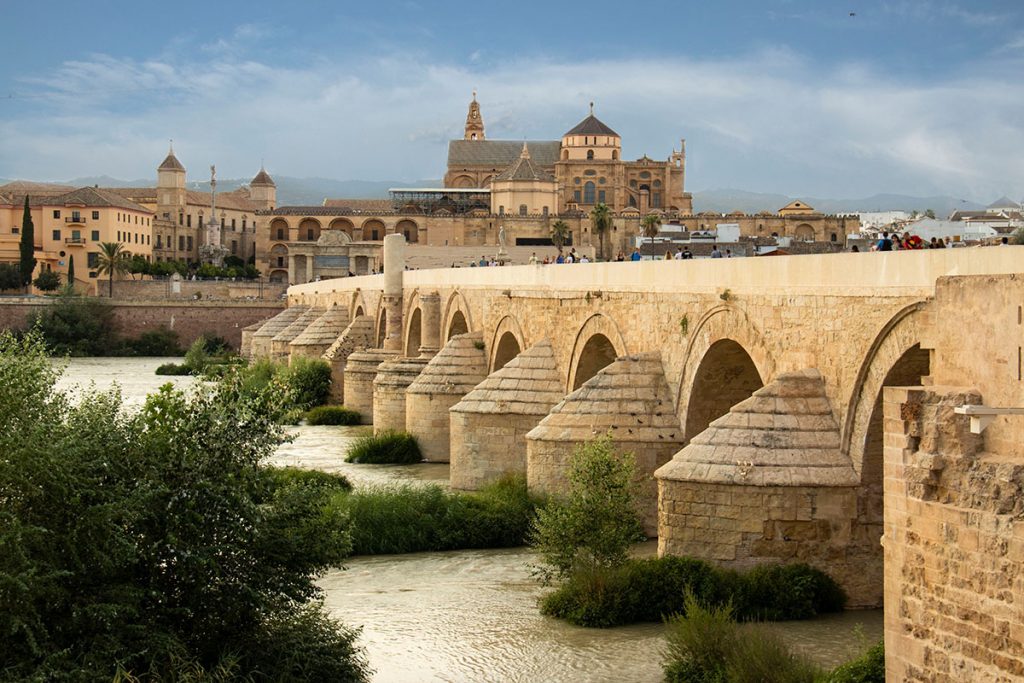
Cordoba, the beautiful Andalusian city, is a bit of a hidden gem that many tourists skip for more famous Spanish cities; however, for history lovers and UNESCO enthusiasts, a visit to Cordoba is a must.
Walking through the charming historic centre of Cordoba, most of which has already been recognised as a UNESCO World Heritage Site is such a pleasure. From the beautiful alleys of the old Jewish Quarter to leafy green patios, chapels and synagogues, there are many monuments to admire.
Start with the most famous attraction in the city, the Great Mosque of Cordoba, known as the Mezquita, which was listed as a UNESCO Heritage Site in 1984. The Muslims built this extravagant mosque in the 8th century, and it’s considered to be one of the largest in the world.
However, what makes it so unique is not it’s size but the architecture. The hundreds of columns, the red and white arches, the impressive ribbed dome and the beautifully decorated doors all make it an extraordinary sight. Since this is the main tourist attraction in the area, try and come early to avoid the crowds.
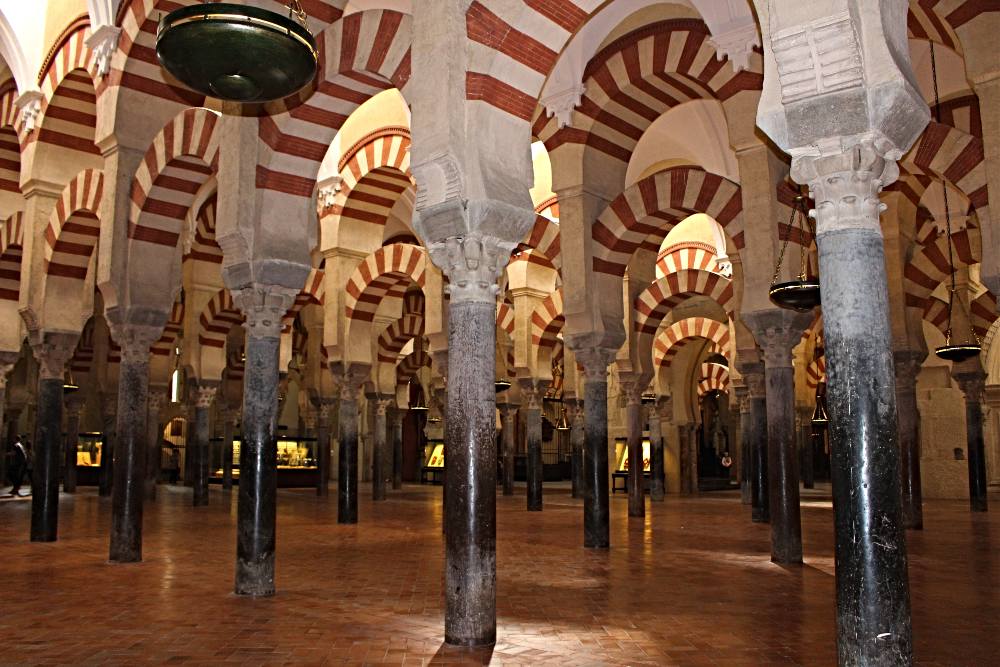
Two other must-see attractions are the Calahorra Tower and the Roman Bridge, from here you’ll also get to see Cordoba and its river in their full glory. The views are so beautiful both during the day and during the night that it is best to visit would be in the afternoon so you can experience both. Watch the golden colours of the sunset and then enjoy the sight of Cordoba and its historic centre illuminated so beautifully at nighttime.
With all these sites it’s no surprise that Cordoba has its own Hop on Hop off bus that is a great way to see the city in a day.
Getting there: Cordoba is located only 2 hours away from Madrid by a fast train.
Read more about the attractions of Cordoba on The Chasing Lenscape website.
Madinat al Zahra
Naomi from Probe around the Globe shares her visit to one of Spains most recently recognised UNESCO sites just outside of Cordoba
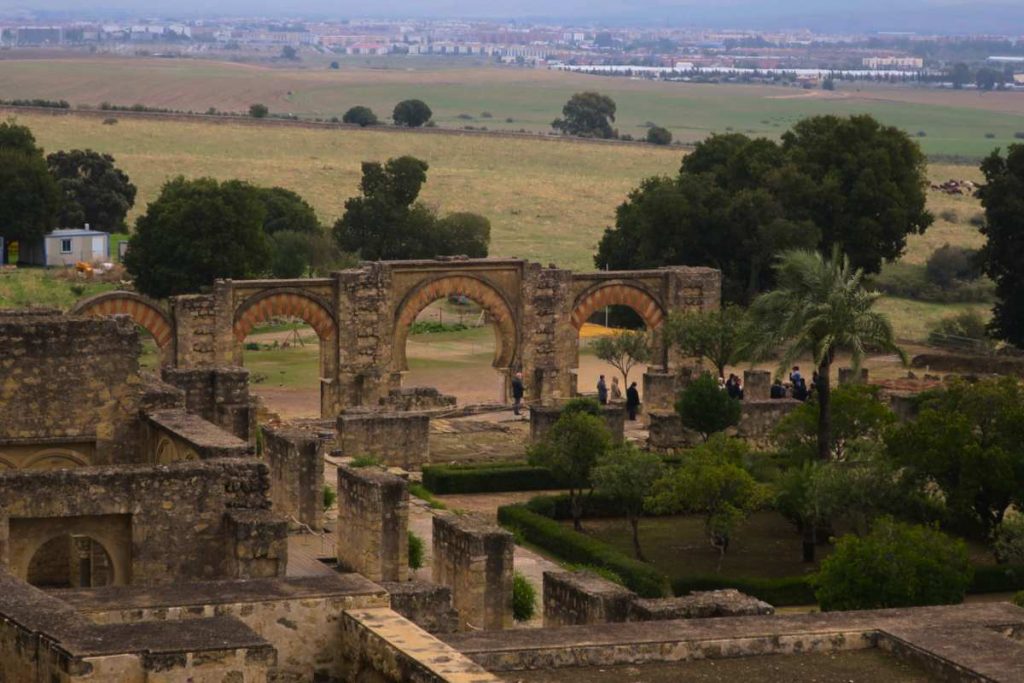
The archaeological site of Madinat al Zahra (also named Medina Al Zahara) was recently added by UNESCO to their World Heritage List. And rightly so! When you visit the ruins, just outside of Cordoba, you’ll see the history of a grand city structured palace unfold before you in the hills. Caliph Abd al Rahman III built the city around 940 AD. You can roam through the streets of the city, walk under the arches and recognize the same stripped decor, similar to the famous Mezquita of Cordoba.
The city of Madinat al Zahra was only used as the capital of the Caliph for 35 years before it was sacked. Although much of the historic city was used as a building material for the surrounding landscape, what remains today is enough to show the grandeur of city with the market square, the porticos and the house of the prime minister as top sights to see. Whenever you’re close to Cordoba, make sure to check out the newest addition to the Unesco World Heritage list!
Getting there: Madinat al Zahra is located only 8 km west of Cordoba, which makes for an easy day trip from Cordoba or a half day tour from the city. You’ll start at the museum where you can get your free ticket for the shuttle bus to the ruins.
There are lots of affordable day tours to Madinat al Zahra on offer, we like this 3 hour one comes with a drink and a tapa for under $30
Read more about Naomi’s day trip to Madinat Al Zahra here.
Toledo
Michelle from Travel After Five shares her knowledge on Toledo which makes an excellent day trip from Madrid and a must for anyone interested in history.

The UNESCO historic city of Toledo was Spain’s old capital before it was moved to Madrid. The city has a history of Christians, Muslims, and Jews living together within its walls, giving rise to unique architecture and a variety of churches and mosques to explore.
The Toledo Cathedral, formerly known as the Primate Cathedral of Saint Mary of Toledo, is the fourth largest cathedral in the world and is well worth a visit. The entry fee includes an audio tour that gives an excellent description of the unique and phenomenal interior.
After your visit to the cathedral, check out Alcázar de Toledo, an old stone fort. This military museum can keep you busy for an entire afternoon and is located at the highest point of the city.
Getting there: You can reach Toledo easily from Madrid as a day trip. It is a short drive if you have a car or you can take the train from Madrid in under an hour. There is no need to buy your ticket in advance. Just purchase one the day you plan to go.
Tip: Once you arrive at the station in Toledo, you can take a bus to the city, or take a 15-minute scenic walk. Hop-on-hop-off tours are available; however, the town is very walkable if you choose to go the less expensive route. Another option is the cute tourist train that travels around the city and is very affordable.
If you prefer a guided tour, this full-day tour from Madrid includes a walking tour with a guide as well as lots of free time to enjoy Toledo.
Follow more of her travels on her website Travel After Five.
The Alhambra
Charles and I visited the Alhambra on our 6 week trip to Spain and after more than 40 years of travelling, I can say with certainty that this is my favourite site in the world.

The Alhambra was added to the list in 1984 and is the only surviving palatine city of the Islamic period . One of the top sites in Spain if you could only visit one site on this list this is the one I would recommend.
The Alhambra site is extensive and made up of a 9th-century fortress, two palaces and extensive gardens. To tour the entire site will take you at least 3 hours although you could easily spend an entire day here. You can read more details about the site on our 3 days in Granada itinerary.
This is one place you need to be really organised as a limited number of visitors per day and it sells out months in advance. You can book tickets or more extensive guided tours depending on your level of interest.
Getting there: You can reach Granada from Malaga (a great budget airport) in an hour. The Journey from Madrid takes about 4 hours.
The Albaicín Granada
Joanne from family travel blog Sunsets and Roller Coasters enjoyed her time in Granada as we did and shares Granada’s second site the Albaicín.
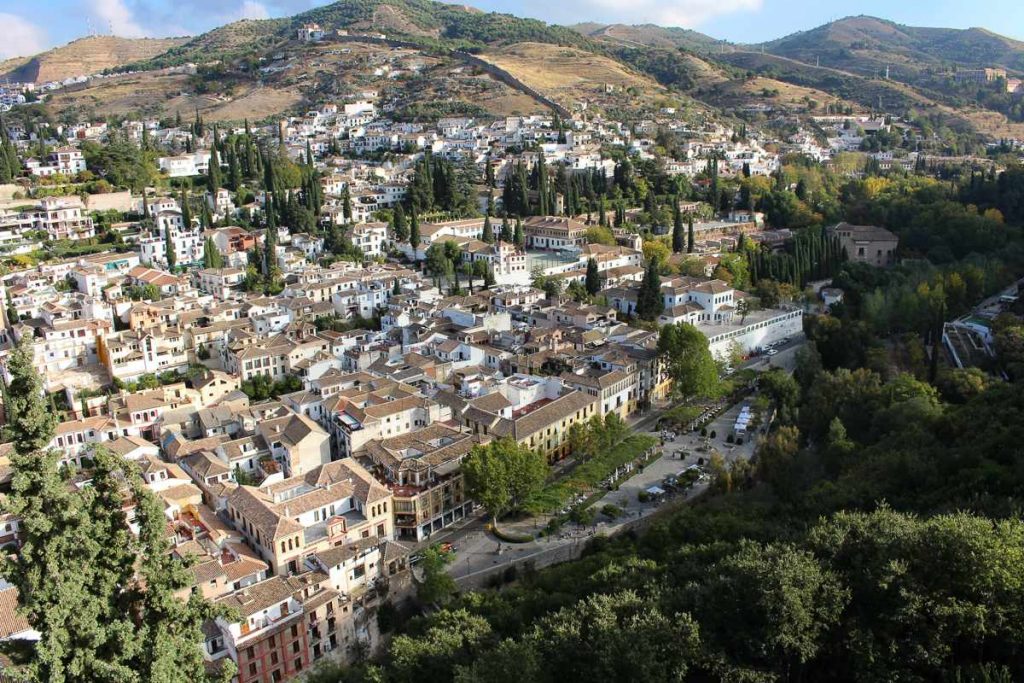
The Albaicín and the Alhambra are located on two adjacent hills, separated by the river Darro, and together they form the medieval centre of Granada. The Alhambra was named a World Heritage Site in 1984 and it was extended to include the Albaicín ten years later.
At one time, much of Andalucia, including Granada, was under Muslim rule. The Albaicín is the old Arab quarter of Grenada that is filled with narrow, winding streets that travel on a very steep hill. At one time, this area housed over 30 mosques. During the Reconquista, in the late 1400s, the Catholic monarchs overturned Muslim rule. They destroyed the mosques but allowed the Moors to remain in their homes in the Albaicín. Over time, much fighting continued and the Moors were expelled, leaving their homes to the remaining Christians to build their carmenes.
These carmenes, typical homes in Granada’s Albaicín, have walls that separate them from the street and often include an inner garden which looks up at the incredible Alhambra. We were fortunate to be able to stay in a beautiful carmen during our stay in the Albaicín and it was beautiful. We highly recommend looking for one when booking accommodation in Granada.
Whether you stay in the Albaicín or not, you have to explore this amazing area while in Granada. The Albaicín is close to Plaza Nueva and there are several buses that travel through the maze of narrow streets. Due to its steepness, it’s better if you start to explore from the top and work your way down.
Tip: While at the top, don’t miss the Mirador San Nicolas, a scenic outlook next to San Nicolas Church, as it has one of the most beautiful views of the Alhambra. The Albaicín is also home to 11th-century Arab baths, markets and wonderful restaurants. It’s truly worthy of UNESCO distinction!
Follow more of Joanne and her families travels via their Pinterest boards.
Seville Cathedral and Real Alcazar
Helen who writes at Helen on her Holidays brings us one of my most memorable Spanish sites in Seville.
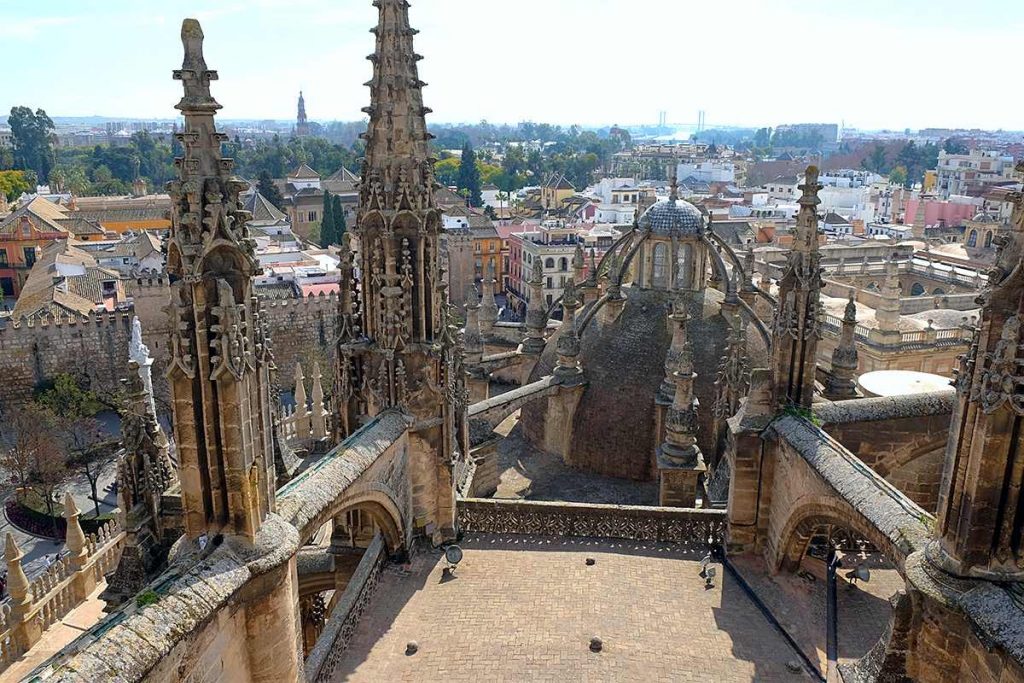
Seville Cathedral and the Real Alcazar form a single UNESCO site in Seville, Spain. On the UNESCO list since 1987, the two sights are just steps from each other and are both fascinating, in very different ways.
Seville Cathedral was built in the 12th and 13th centuries, but not as a Christian church. The original purpose of the building was a mosque, and parts of the structure still hint at Islamic roots; the famous Giralda tower was originally the minaret.
The magnificent cathedral visitors see today was built to show how powerful and wealthy Seville had become. When the decision was taken to revamp the old mosque, the cathedral elders said: “Let us build a church so beautiful and so grand that those who see it finished will take us for mad”.
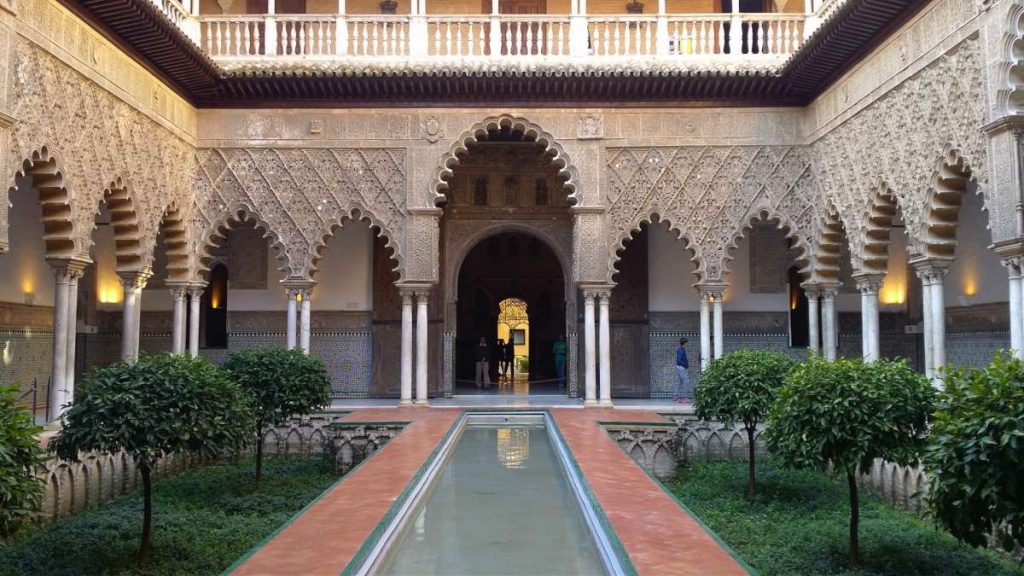
The Real Alcazar is a beautiful complex of Royal palaces, some of which are still in use by Spain’s royal family. They’re set in stunning gardens, full of fountains, orange groves and even resident peacocks. Inside the Real Alcazar’s walls, you can imagine that you’re a royal yourself as you stroll through the grounds.
It’s really easy to visit Seville Cathedral and the Real Alcazar, although both sights require a little planning, especially if visiting in Spring and Summer.
You can buy tickets for the Real Alcazar online in advance, and it’s well worth doing so if you’re visiting at a busy time.
Getting there:
Tip: When you visit the Seville Cathedral I’d recommend doing the rooftop tour, which you can book in advance. It really enhances the experience.
The Old Town of Cáceres
Justine Ancheta from Latitude 41 shares her visit to Cáceres.
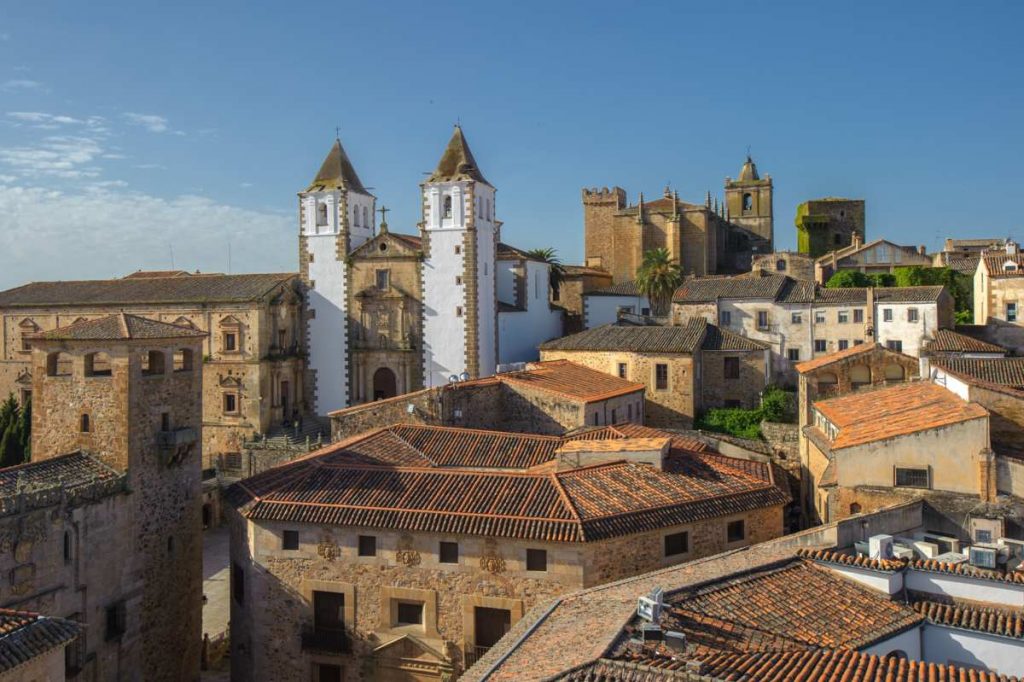
Declared a UNESCO Heritage site in 1986, the Old Town of Cáceres is a testament to the history’s ancient battles starting from pre-Roman times. This quaint town in Extremadura has been occupied by the Romans, Arabs, Jewish and Christians. It’s incredible how structures have been well-preserved like the 15th-century church and convent of San Mateo built on a mosque, the baroque-style church of San Francisco Javier, and the 12th-century Tower of Bujaco.
You’ll be impressed to see 30 towers still standing strong, all the way from Moorish times! Because of its well-preserved architecture, it’s also one of the filming locations for the Game of Thrones and other period film and TV series. It’s also interesting to see the juxtaposition of modern life in the Plaza Mayor, where teenagers, young families, and grandmothers relax among the ancient buildings.
Old Town Cáceres is also quite peaceful – unlike other highly touristic Spanish cities like Madrid or Barcelona. Be sure to look for the unique stork nests in random trees and rooftops and peacocks meandering about the cobblestone streets.
Getting there: To reach Cáceres take the train from Madrid to Cáceres Railway Station. The trip takes about 4 hrs. The station is about one kilometre from the city centre. It’s free to walk around the Old Town, so you don’t have to do any special planning.
Read more about the beautiful medieval old quarter of Cáceres on Justine’s blog Latitude 41
Cuenca
James Ian at Travel Collecting shares the marvel of the hanging houses at Cuenca.
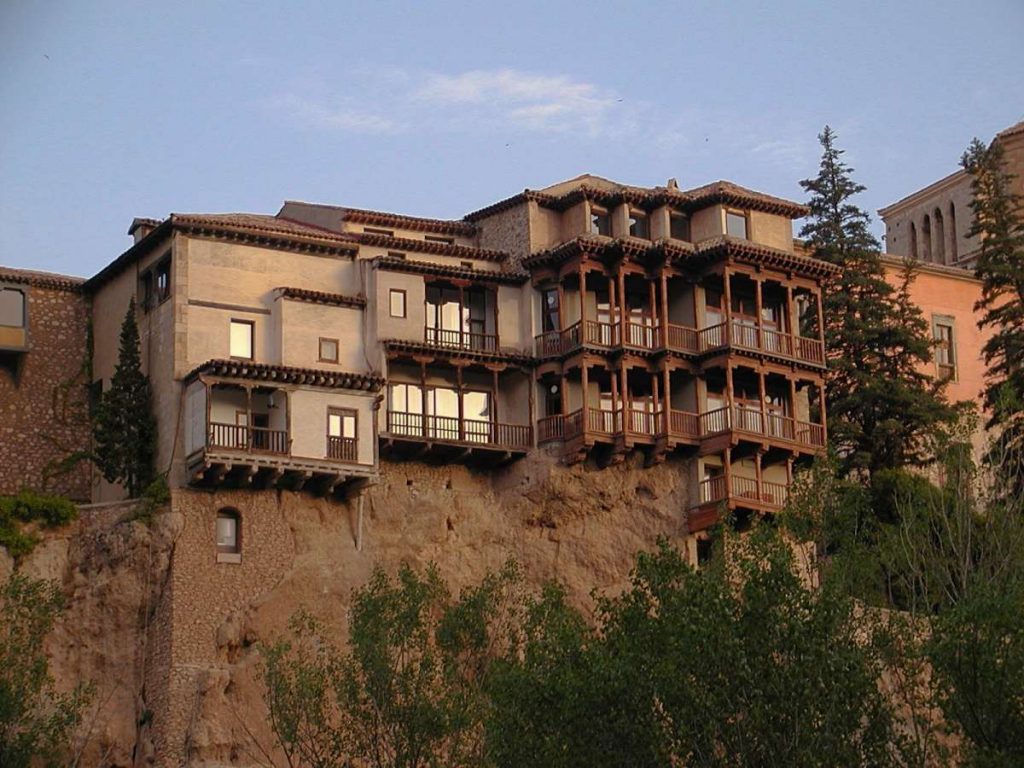
The walled town of Cuenca sits atop a rocky outcrop surrounded by a deep gorge. The houses sit right on the edge of the cliffs. In fact, several of these houses have balconies that jut out over the empty space, with the ground far below. This has created the moniker “casas colgantes” or “hanging houses”. There is a narrow footbridge, the San Pablo Bridge, stretching over the gorge right beside the balconied houses, providing wonderful views of them.
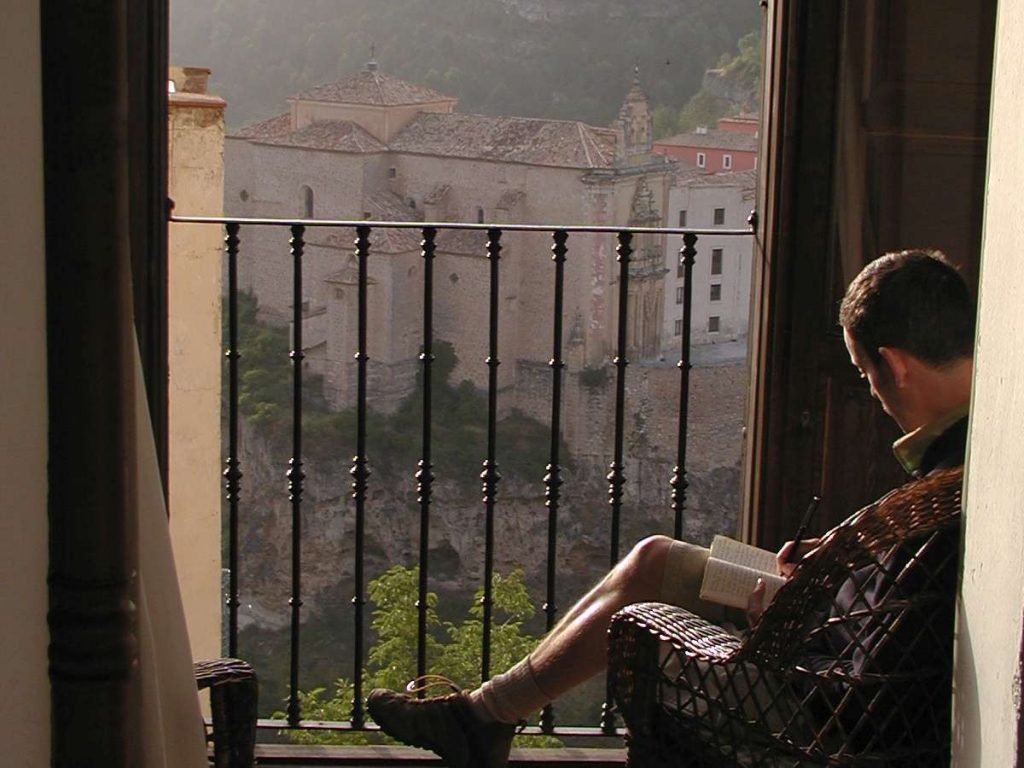
However, Cuenca is more than this strip of cliffside houses. The main square, the Piazza Mayor, of the medieval village has several restaurants where you can hang out, enjoy tapas and sangria and watch the world go by. There are large arches, providing a narrow entrance that vehicles need to squeeze through. The town is made for walking, and you can easily spend a day wandering the steep, narrow, winding streets and exploring cute shops and stopping off at delightful cafes along the way.
There are also several viewpoints from the surrounding hills, and a stunning old monastery that has been converted into a Parador, a luxury hotel with views of the gorge lit up at night, that makes a perfect place to appreciate the historic walled town.
If you are staying in Madrid you can do a full day tour that includes a visit to the hanging houses and plenty of free time to explore
Getting there: From Madrid a high-speed train will have you to Cuenca in under an hour. From Valencia it is about 1 hour by bus.
El Escorial
Corina from Another Milestone is sharing her experience of El Escorial.
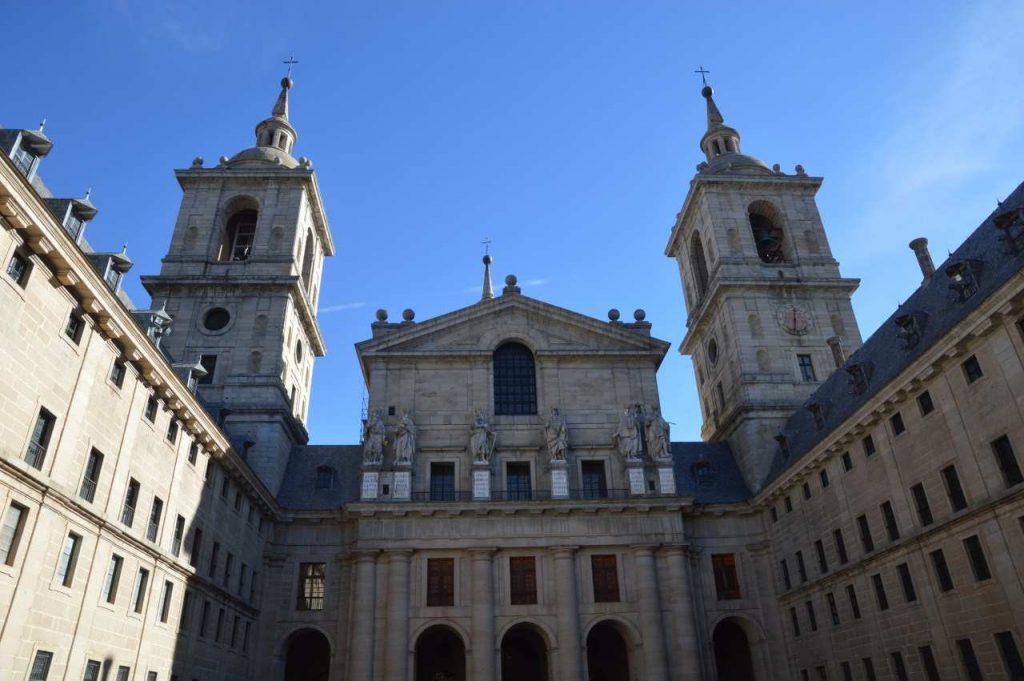
El Escorial, the castle-monastery built in 16 the century, is located 1-hour drive outside Madrid, making it perfect for a day trip.
Once you are there, you will need around half a day just to explore the place. Pay attention to the hidden details in the library, visit the two palaces (Bourbons and Felipe II), enter the basilica and descend the stairs to see where the kings of Spain and other royal family members are buried.
The king’s tombs were the most interesting part of the complex, but if you like mysteries, you can spend more time in the library. Around 40000 books and manuscripts are kept here among colourful paintings, scientific instruments and hidden symbols. There, you will understand why this place is UNESCO heritage.
Getting there: From Madrid, you can get there by car or by train, but the road from Avila to El Escorial will offer you the perfect view of the monastery.
If you prefer not to drive this day tour from Madrid is a good option.
Tip: If you come by car, there is a big parking lot just in front of the monastery. From the train station, you must walk around 20 minutes through the park. To visit the complex, you need to climb and descend a lot of stairs, so it is not accessible for wheelchairs or strollers.
Las Médulas
Fellow Aussie Shandos from Travelnuity shares the amazing Las Médulas in Northern Spain.
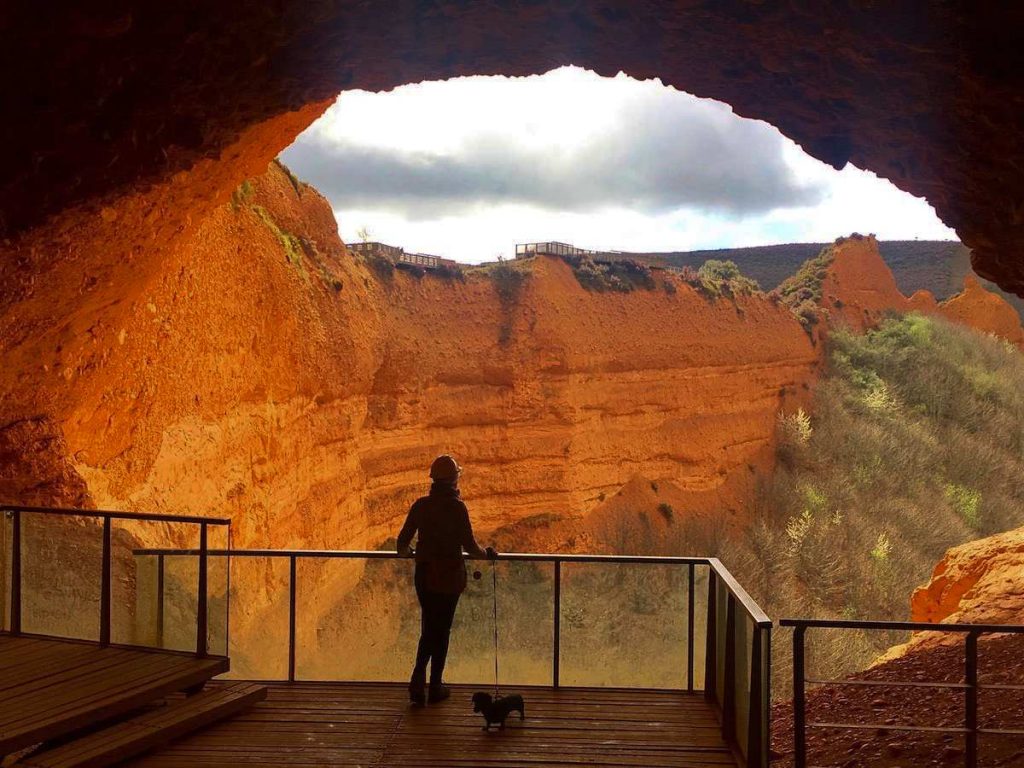
One of my favourite World Heritage sites in Spain is Las Médulas. Spain is home to multiple impressive Romain ruins, in particular at Mérida and Tarragona (both also World Heritage sites), but the ruins at Las Médulas aren’t your typical Roman ruins.
Las Médulas was an ancient Roman gold-mining site, the most important gold mine in the entire Roman empire. The technique used here to mine vast quantities of gold wasn’t your typical mining process. Instead it was known as “ruina montium” or “wrecking of the mountains”. It utilised large quantities of water to literally destroy the mountains, with the gold deposits being found in the outflows of water. The resulting landscape looks like the weathered canyons found in southwestern USA.
The highlight of our visit was entering one of the old Roman tunnels (after paying a small fee). It was incredible walking through a tunnel that dates back to Roman times. Luckily we were wearing hard hats, just in case, although our dog was also allowed to enter, no hard hat required.
I also recommend taking in the view of the area from the multiple look-out points (search for Mirador de Orellán on Google maps), and taking a hike through the resulting valleys.
Getting there: The area isn’t easily accessed by public transport. Instead, I recommend stopping off by car on your way to or from Santiago de Compostela or northern Portugal.
Shandos has been exploring Europe with her dog Schiztnel and has lots of advice about exploring UNESCO sites in Spain with your furry friend.
Sagrada Familia
Diana from Elusive Family has been based in Europe for the past four years. This young family found la Sagrada Familia a very special spot.

Located in Barcelona, Spain the Sagrada Familia is an amazing piece of architectural history. Designed by Antoni Gaudi, this enormous cathedral is still being completed, more than 135 years after it began. The cathedral is a spectacular combination of Gothic and Art Nouveau architecture and its exterior is mesmerizing for its intricate design and detail.
The interior of the cathedral has beautiful stained-glass windows that are span across entire walls and are floor to ceiling in some areas. As a result, when the shine suns through, there is a kaleidoscope of dancing colours on the floor of the cathedral during the daytime. Many of the columns found inside are made of volcanic rock, basalt or granite. The columns and design create an ethereal and enchanting forest-like atmosphere inside the cathedral.
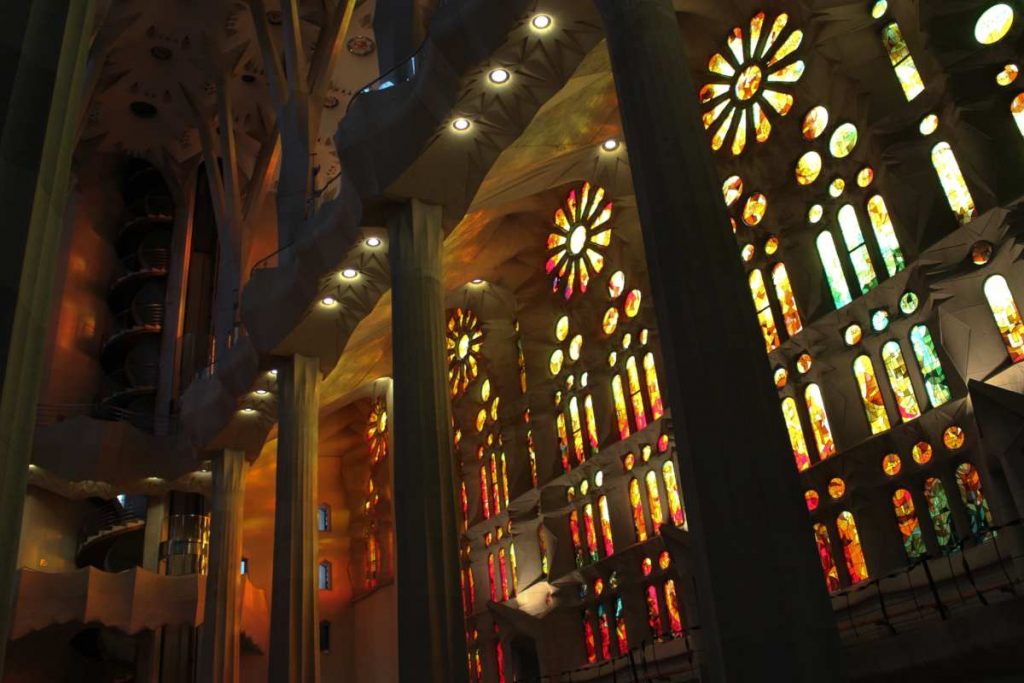
La Sagrada Familia is the most visited tourist spots in Barcelona drawing millions of annual visitors. Buy tickets in advance for a specific time to avoid the long queues which can sometimes stretch several hundred people long. There are six options to purchase tickets including an option of visiting one of the towers.
You can also book a guided tour if you would like to learn more about the building on your visit.
Getting there: Reaching the cathedral is simple via public transport. The closest Metro lines are the 2 and 5, at the exit for Sagrada Familia Station or take one of the nine different buses that have stops nearby the cathedral.
Check out some more of their family travels on their website.
Casa Mila
The Wyld Family from Australia are on a world tour and currently based in South East Asia. We almost crossed paths with them in Spain when they disembarked a flight that we were waiting to board!
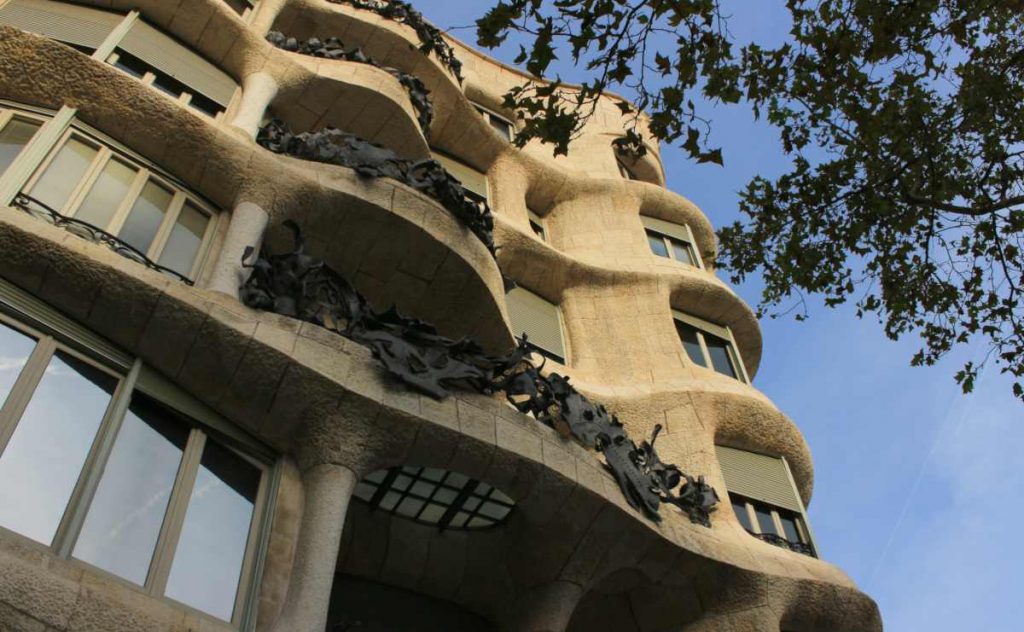
Casa Mila in Passeig de Gracia was the last private residence that Gaudi built in Barcelona. It is also one of the most recognisable attractions in Barcelona and received UNESCO World Heritage status in 1984.
The stone quarry as it is known because of its resemblance to an open quarry was built between 1906 and 1912. Its ripple stone facade and 32 warped wrought iron balconies make it a truly unique design.
A visit can be one of the coolest things to do in Barcelona, however, unlike many of the other sites here entry is not free. The inside is just as amazing as its facade and worth touring. The rooftop provides an amazing view over the city of Barcelona.
In peak seasons there are often long lines so this is one site you should consider buying tickets for in advance if you plan on touring.
Getting there: Casa Mila is in Barcelona. Take the subway to Station Diagonal ( Line 3 or 5)
Segovia
Or, from My Path in The Word lists Spain as her favourite country in the world and she thinks Segovia is up there when it comes to the top UNESCO spots in Spain.
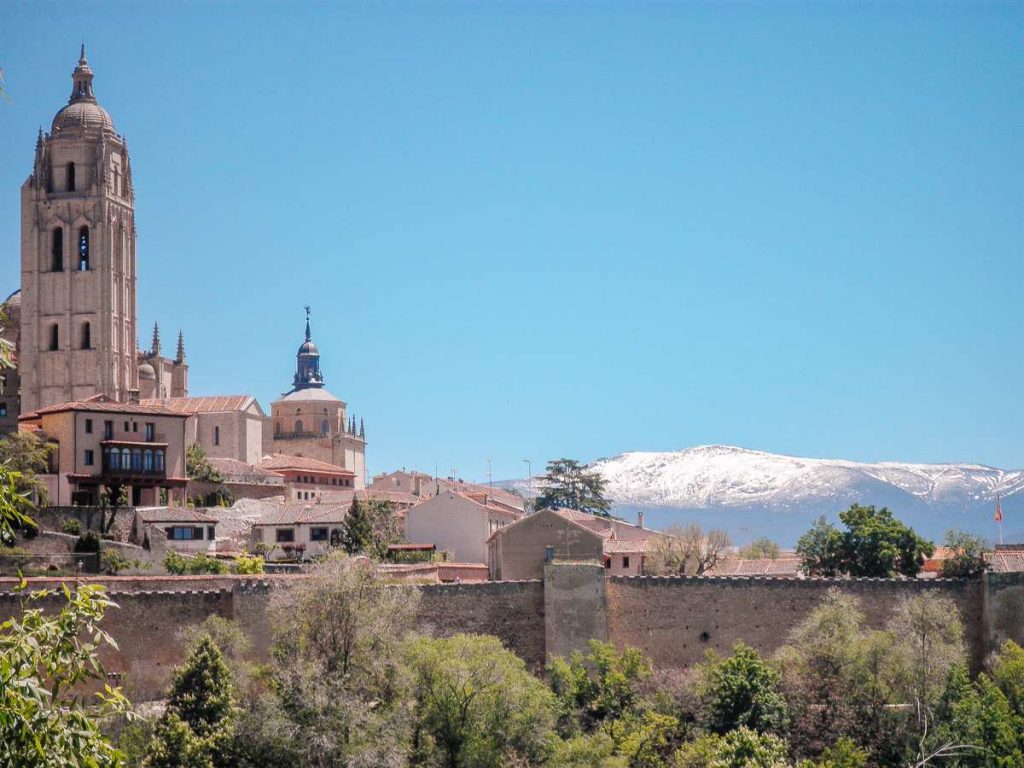
Perfect as a day trip from Madrid, Segovia is one of the best places to see UNESCO Sites in Spain.
Arriving in Segovia, the first landmark you’ll notice is its Aqueduct. Not only is it an important historical monument standing for almost 2,000 years, but also a Roman architectural gem consisting of about 25,000 blocks and 170 arches. But the undeniably beautiful aqueduct is not the only World Heritage Site in Segovia.
Thanks to some incredible monuments, the old city of Segovia is another UNESCO Site worth exploring. The two most important ones you should visit are the Alcazar of Segovia, a medieval royal castle that looks like it belongs in a fairytale, and the Segovia Cathedral, the last Gothic cathedral built in Spain.
Dating back to Moorish times, you can also climb the Walls of Segovia to enjoy some remarkable views over the city. If that’s not enough, Segovia’s old city is also home to several Jewish sites like El Pinarillo cemetery and the former main synagogue.
Getting there: From Madrid, the easiest way to get to Segovia is by train. I recommend booking your ticket in advance on Renfe’s (the Spanish train company) website. If you want to discover Segovia’s treasures with a guide, you can also book a guided day tour from Madrid.
You can also take a guided tour from Madrid that includes a 1.5-hour walking tour and 3 hours of free time.
Check out Or’s Instagram feed for some more fabulous views of Spain.
The Old City of Salamanca
Joel Baldwin from World Heritage Journey is on a mission to visit all the World Heritage sites he can find. He thinks Salamanca is pretty special.

Spain is blessed with many “Old City”-type World Heritage sites, but the Old City of Salamanca might be the most interesting of them all. Located in Castile & León in western Spain, the city of Salamanca has a fascinating history. The biggest attraction in town is the incredible University of Salamanca, the world’s third-oldest university – dating back to 1218! University students make up a large percentage of the town’s population, giving it a vibrant atmosphere any time of the day and night.
Salamanca is also home to a gorgeous and unique Cathedral; actually, two separate cathedrals combined into one building! You have the Old Cathedral from the 12th century, built in a Romanesque style, and then right alongside (sharing a common wall!) is the New Cathedral, built in Gothic and Baroque styles during the 16th and 17th centuries.
Wandering around inside the old city is a great experience, as there’s much more to see including the magnificent Plaza Mayor, Casa de las Conchas, many beautiful sandstone buildings, and a 2000-year old Roman bridge.
Getting there: Getting to Salamanca is quite easy, as it’s just a short 90-minute RENFE train trip from Madrid. There are also bus options from Madrid, and it’s well connected to Spain’s excellent freeways – though parking in the Old City area will be a challenge!
You might like to take an affordable guided tour with a local to get an insider view of Salamanca.
Tip: Make sure you visit the local tourism website before which has lots of great information and even a smartphone app with a built-in walking tour and audio guide!
I highly recommend you take a look at Joel’s World Heritage Journey channel on Youtube for an amazing collection of historic sites.
Serra de Tramuntana
Linn from the Brainy Backpackers travel blog has visited the Serra de Tramuntana on the island of Mallorca.

Serra de Tramuntana in Mallorca was awarded a UNESCO world heritage site in 2011, because of the great physical and cultural significance of the area. The mountain range stretches across the islands northwest coast and besides amazing hiking opportunities, there are some breathtaking views, mighty cliffs, adorable beaches and charming villages to explore. The rural landscape is dominated by ancient stone terraces covered in old olive trees and colourful citrus trees. In the winter months, the almond trees blossom and cover the countryside in beautiful, white flowers.
The small picturesque villages have been popular among foreign artists during generations. Among others, the British poet Robert Graves used to live in Deia and the famous pianist Chopin lived in Valldemossa during a period where it is said he wrote his most beautiful pieces. With the surroundings of these villages, I am not surprised.
Getting there: The best way to explore Tramuntana is by car. This way you can visit all the little villages and enjoy the best viewpoints. You can easily rent a car at the airport for a road trip in Mallorca. However, there are bus services from Palma as well as the iconic tram running between Palma and Soller. The easiest way to get to Mallorca is by plane, though you can take a ferry from Barcelona (7,5 hours), Valencia (7,5 to 8 hours) or Denia (5 hours) in Spain mainland.
You can stay up to date with the Brainy Backpacker on their Facebook page.
Teide Natural Park in Tenerife
Amber from Food And Drink Destinations takes us to a little part of Spain that sits off the coast of Africa.
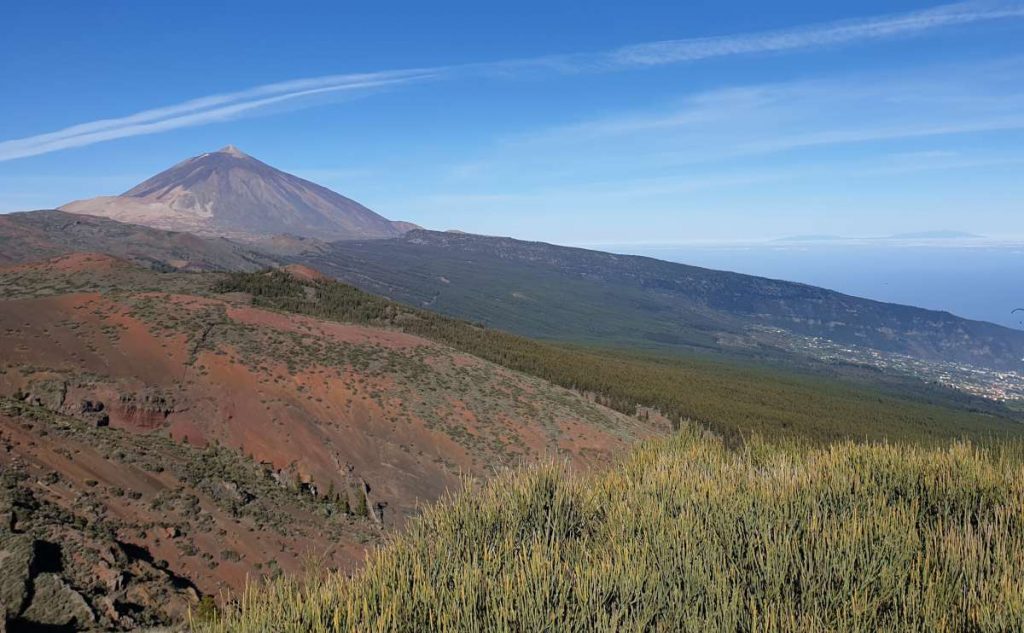
Teide National Park is located on the north end of Tenerife, one of the Canary Islands. The Canaries are a Spanish archipelago located off the coast of Northwestern Africa.
Teide Natural Park is a haven for nature lovers and hikers, but its main attraction is the dormant volcano located at its centre, which represents the highest point in Spain. To reach the summit, you can trek to the top, or take the handy cable car that makes the journey in only 8 minutes. Once at the top, be prepared for high altitudes because the observation area is about 2200 meters high.
From where the cable car lets out, it would take another 45 minutes or so to actually hike to the true summit of the volcano. The view from the observation area, though, is enough for most travellers. On a clear day, you can see much of Tenerife and the neighbouring highlands. The volcanic natural park is reminiscent of Mars in many spots and is a truly unique destination.
Teide Natural Park is one of the most popular tourist destinations on Tenerife, so it is best to reserve your cable car journey before arriving. It is even better to arrive early in the day when crowds are less and the chances of a clear view are better.
Camino de Santiago
Solo Traveler Jacomijn from Safe and Healthy Travel is the first of our two Camino walkers sharing their experiences of this epic 800km trek with us.
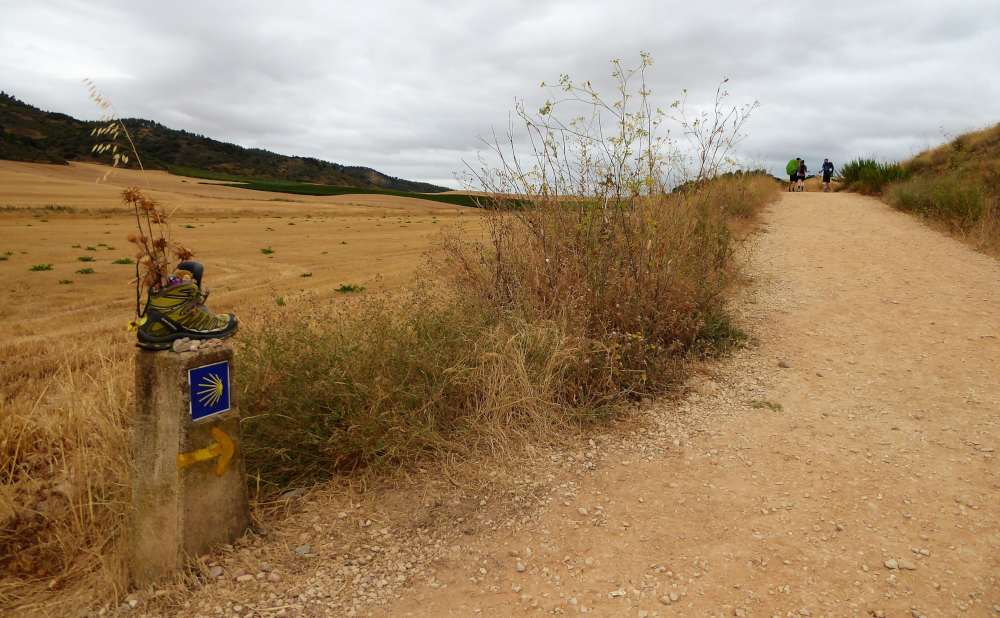
The Camino de Santiago, the way of St James, is an ancient old route that pilgrims walked to get to the tomb of St. James who was an apostle of Jesus. It started early 9th century when the tomb of St James was found in the cathedral of Santiago de Compostela, Spain. Since then multiple routes have been created and I have walked that route in Spain from France. The starting point of that route: Saint Jean Pied de Port – France, in the Pyrenees, and so that route is called the Camino Frances, the French Route and took me around 800K walking to the tomb of St James.

It is a wonderful route that takes you through different landscapes and the most beautiful villages and cities. On the way you can visit cathedrals that the pilgrims visited on their pilgrimage. In the beginning of this route you walk the Pyrenees and slowly you enter the Meseta, a hard part for some as it has long stretches and not much to see. Last part takes you into Galicia which also gives other landscape and a totall different feeling.
Getting there: Starting the route is best done from France, flying into Toulouse or Bordeaux and then take the train for that last part to Saint Jean Pied de Port. Everything will be easy from there on. Lots of albergues (hostels) are there to sleep and lots of other pilgrims to help you along the way. For me, it is one of my best travel experiences ever. I was a pilgrim for 35 days and still miss my pilgrim life.
Read more detail on Jacomijn’s first 200 kms of the Camino.
Camino 2
Sam from Alternative Travellers has a slightly different type of site, one that is over 800km long and one that Charles is walking right now!
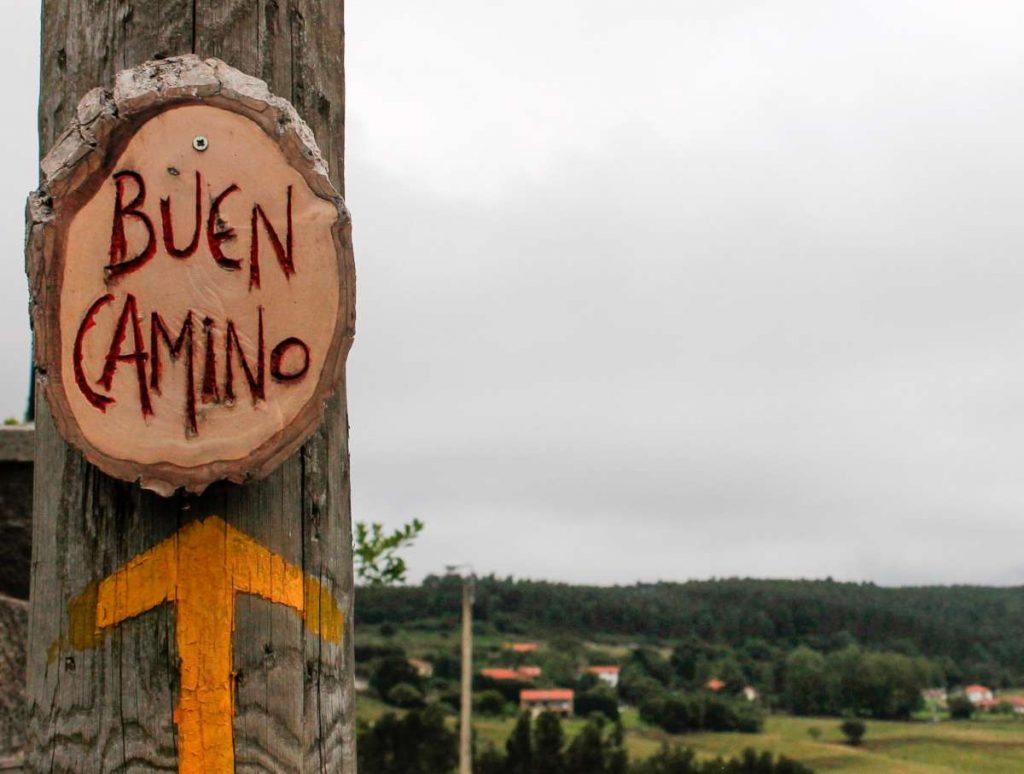
The Camino de Santiago is a different take on the traditional UNESCO site. Also known as the Way of St. James, this site is a medieval pilgrimage trail that stretches across northern Spain. Pilgrims follow the trail markers of yellow arrows and shells through a diverse range of landscapes and cultures, finishing in the beautiful city of Santiago de Compostela. St. James is said to be buried in the cathedral in Santiago, and his crypt is the reason why medieval pilgrims undertook the journey. Today people from all walks of life walk the route for a variety of reasons.
There are many different routes leading to Santiago, with the oldest being the primitive route through the mountains in the region of Asturias. In order to receive the “compostela,” or official document that shows completion of the journey, pilgrims must walk at least the final 100 kilometres.
In many ways, the Camino is a “choose your own adventure” affair, as you can choose to start wherever you like, walk as much or as little as you like each day, and spend very little as a budget pilgrim or stay in more luxurious accommodations. Packing for the Camino is essential, as you’ll be carrying days or weeks worth of gear on your back.
Getting there: Due to the well developed Spanish train system, it is quite easy to get to the Camino. Most travellers will fly into major airports (like Madrid) and take a train or bus to their starting point
So there you have it, 20 of the 47 UNESCO sites in Spain. You will find the full list here if you want to continue exploring.
Save these UNESCO sites in Spain to Pinterest for your holiday planning
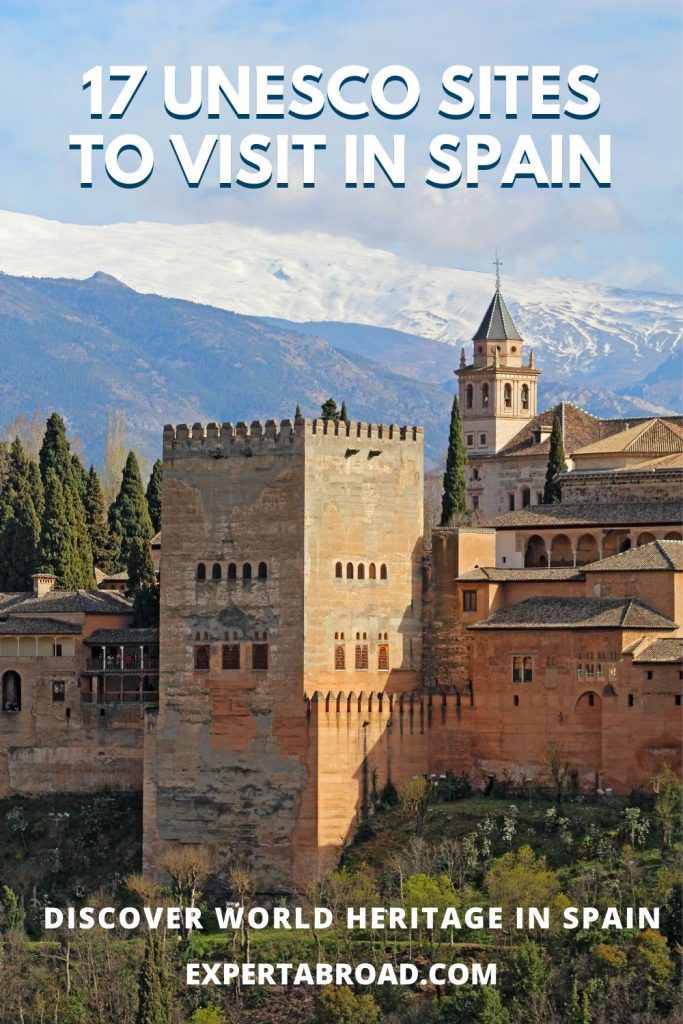


Have a question about something here? Want advice for planning your visit? Head to our Facebook page and we will do our best to help.
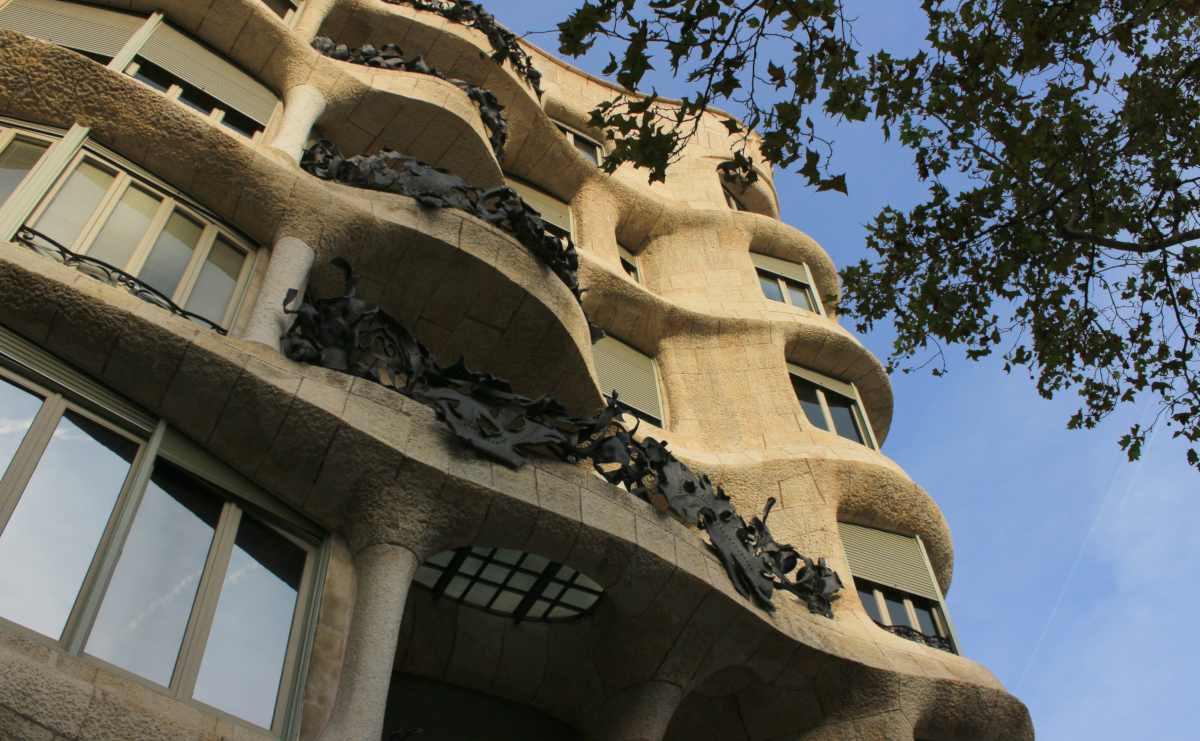


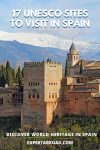
After study a few of the blog posts on your website now, and I truly like your way of blogging. I bookmarked it to my bookmark website list and will be checking back soon. Pls check out my web site as well and let me know what you think.
My brother recommended I might like this blog. He was once totally right. This put up truly made my day. You can not believe simply how a lot time I had spent for this information! Thank you!
I will immediately grab your rss feed as I can’t find your email subscription link or e-newsletter service. Do you have any? Kindly let me know in order that I could subscribe. Thanks.
I was curious if you ever thought of changing the structure of your site? Its very well written; I love what youve got to say. But maybe you could a little more in the way of content so people could connect with it better. Youve got an awful lot of text for only having 1 or 2 pictures. Maybe you could space it out better?
A powerful share, I simply given this onto a colleague who was doing somewhat analysis on this. And he actually bought me breakfast as a result of I found it for him.. smile. So let me reword that: Thnx for the treat! However yeah Thnkx for spending the time to debate this, I really feel strongly about it and love studying more on this topic. If possible, as you develop into expertise, would you mind updating your weblog with extra particulars? It is highly useful for me. Large thumb up for this blog post!
A powerful share, I just given this onto a colleague who was doing a bit evaluation on this. And he in fact bought me breakfast as a result of I discovered it for him.. smile. So let me reword that: Thnx for the treat! However yeah Thnkx for spending the time to debate this, I really feel strongly about it and love reading extra on this topic. If attainable, as you develop into experience, would you thoughts updating your blog with more particulars? It is extremely useful for me. Big thumb up for this blog post!
ProNerve 6 nerve relief formula stands out due to its advanced formula combining natural ingredients that have been specifically put together for the exceptional health advantages it offers.
I have been surfing online more than 3 hours today, yet I never found any interesting article like yours. It is pretty worth enough for me. In my opinion, if all web owners and bloggers made good content as you did, the internet will be a lot more useful than ever before.
Tonic Greens: An Overview Introducing Tonic Greens, an innovative immune support supplement meticulously crafted with potent antioxidants, essential minerals, and vital vitamins.
You need to participate in a contest for top-of-the-line blogs on the web. I will recommend this web site!
What Is Kerassentials? Kerassentials is a doctor-formulated oil for healthy skin and nails.
Perfectly pent content, appreciate it for entropy. “Necessity is the mother of taking chances.” by Mark Twain.
Hey! This post could not be written any better! Reading this post reminds me of my good old room mate! He always kept chatting about this. I will forward this article to him. Pretty sure he will have a good read. Many thanks for sharing!
I must express appreciation to this writer for bailing me out of this scenario. Right after researching through the the net and obtaining principles which are not beneficial, I was thinking my life was gone. Being alive minus the solutions to the difficulties you have fixed through the website is a serious case, and the kind which could have in a negative way affected my entire career if I hadn’t noticed your website. That natural talent and kindness in dealing with almost everything was important. I am not sure what I would have done if I hadn’t discovered such a stuff like this. I am able to now look forward to my future. Thanks a lot very much for your specialized and sensible help. I won’t think twice to recommend your web sites to any person who should receive support about this area.
After all, what a great site and informative posts, I will upload inbound link – bookmark this web site? Regards, Reader.
Just wanna remark on few general things, The website pattern is perfect, the subject matter is very great. “To establish oneself in the world, one has to do all one can to appear established.” by Francois de La Rochefoucauld.
I really like your writing style, great information, regards for posting : D.
Some truly interesting points you have written.Aided me a lot, just what I was searching for : D.
I like this site because so much utile stuff on here : D.
Thanks a lot for sharing this with all of us you really realize what you’re talking approximately! Bookmarked. Kindly additionally discuss with my web site =). We can have a link alternate contract between us!
I?¦ve recently started a web site, the info you offer on this site has helped me tremendously. Thanks for all of your time & work.
What¦s Happening i’m new to this, I stumbled upon this I have discovered It positively useful and it has aided me out loads. I’m hoping to contribute & aid other customers like its aided me. Great job.
This design is steller! You definitely know how to keep a reader entertained. Between your wit and your videos, I was almost moved to start my own blog (well, almost…HaHa!) Great job. I really enjoyed what you had to say, and more than that, how you presented it. Too cool!
Thanks in favor of sharing such a good opinion, post is fastidious, thats why i have read it entirely
Its excellent as your other content : D, thankyou for putting up. “To be able to look back upon ones life in satisfaction, is to live twice.” by Kahlil Gibran.
When I initially commented I clicked the “Notify me when new comments are added” checkbox and now each time a comment is added I get four e-mails with the same comment. Is there any way you can remove people from that service? Thanks!
I don’t ordinarily comment but I gotta say thanks for the post on this great one : D.
Hmm it seems like your blog ate my first comment (it was super long) so I guess I’ll just sum it up what I submitted and say, I’m thoroughly enjoying your blog. I too am an aspiring blog writer but I’m still new to everything. Do you have any tips for first-time blog writers? I’d certainly appreciate it.
I appreciate, cause I found exactly what I was looking for. You have ended my four day long hunt! God Bless you man. Have a nice day. Bye
Thanks for some other informative site. The place else could I get that kind of info written in such a perfect manner? I’ve a mission that I’m just now running on, and I have been at the glance out for such information.
Thank you for your sharing. I am worried that I lack creative ideas. It is your article that makes me full of hope. Thank you. But, I have a question, can you help me?
I have recently started a website, the info you provide on this website has helped me tremendously. Thanks for all of your time & work.
Pretty section of content. I just stumbled upon your web site and in accession capital to assert that I acquire in fact enjoyed account your blog posts. Any way I will be subscribing to your augment and even I achievement you access consistently rapidly.
I think this is among the most significant info for me.
And i am glad reading your article. But should remark on few general things, The
site style is perfect, the articles is really excellent : D.
Good job, cheers
I am very happy to read this. This is the type of manual that needs to be given and not the random misinformation that’s at the other blogs. Appreciate your sharing this greatest doc.
I am extremely impressed with your writing skills and also with the layout on your blog. Is this a paid theme or did you customize it yourself? Anyway keep up the excellent quality writing, it’s rare to see a great blog like this one these days..
As a Newbie, I am always searching online for articles that can benefit me. Thank you
I have been absent for a while, but now I remember why I used to love this web site. Thanks, I will try and check back more frequently. How frequently you update your website?
Howdy just wanted to give you a quick heads up. The words in your article seem to be running off the screen in Ie. I’m not sure if this is a format issue or something to do with web browser compatibility but I thought I’d post to let you know. The design look great though! Hope you get the issue solved soon. Thanks
Keep working ,splendid job!
Its fantastic as your other blog posts : D, thankyou for putting up.
Wohh just what I was looking for, appreciate it for posting.
wonderful post, very informative. I wonder why the other specialists of this sector do not notice this. You must continue your writing. I’m sure, you’ve a great readers’ base already!
Utterly indited subject material, thankyou for information .
Здравствуйте! Ищу надежного провайдера мобильных прокси в Узбекистане для анонимного серфинга
What Is FitSpresso? FitSpresso is a natural weight loss supplement that alters the biological cycle of the body to burn more calories and attain a slim and healthy body
Byd Chazor – мощный и надежный автомобиль с элегантным дизайном и передовыми технологиями
Спасибо за подробную информацию о стоматологии в Ташкенте! Расскажите, пожалуйста, больше о ценах на услуги
What i do not realize is actually how you’re not really much more well-liked than you might be now. You are so intelligent. You realize therefore considerably relating to this subject, produced me personally consider it from so many varied angles. Its like women and men aren’t fascinated unless it’s one thing to accomplish with Lady gaga! Your own stuffs outstanding. Always maintain it up!
What is Gluco Freedom? Millions of people suffer from blood sugar problems, despite the fact that many factors are beyond their control.
lousy good quality content<br
terrible high-quality company<br
I enjoyed this article. Check out for more
This was quite informative. More at
Youre so cool! I dont suppose Ive read something like this before. So good to seek out someone with some unique ideas on this subject. realy thanks for beginning this up. this website is one thing that is wanted on the net, somebody with a bit of originality. useful job for bringing something new to the internet!
negative excellent material<br
This was nicely structured. Discover more at ##anyKeyword##
Very helpful read. For similar content, visit
Well explained. Discover more at ##anyKeyword##
undesirable excellent
Great job! Discover more at ##anyKeyword##
Appreciate the useful tips. For more, visit
Very helpful read. For similar content, visit
poor high quality merch
hello!,I love your writing so a lot! percentage we communicate extra about your article on AOL? I need a specialist in this area to solve my problem. Maybe that is you! Looking ahead to peer you.
This was very insightful. Check out for more
This was quite helpful. For more, visit
Tại Tâm Beauty Clinic, chúng tôi xuất bản các nội dung đánh giá, bảng xếp hạng liên quan đến ngành làm đẹp, bao gồm các spa trị mụn, spa làm đẹp, spa dưỡng da,… Mỗi thương hiệu được đưa vào bảng xếp hạng đều trải qua quá trình sàng lọc kỹ lưỡng
Dont acquire anything at all from in this article
Thanks for the insightful write-up. More like this at
This was very well put together. Discover more at
Bu harika bir kaynak. Daha fazla bilgi için ‘a göz atın
Thanks for the thorough analysis. More info at
I found this very helpful. For additional info, visit
Useful advice! For more, visit
Appreciate the detailed insights. For more, visit ##anyKeyword##
This was highly helpful. For more, visit ##anyKeyword##
¿Qué opinas del mejor concurso SEO: ##anyKeyword##? ¿Estás particip
Thanks for the thorough analysis. Find more at ##anyKeyword##
Avage AI: Transforme Sua Estratégia de Trading no Brasil
Avage AI é uma aplicação de trading avançada, projetada especialmente para o mercado brasileiro
Appreciate the comprehensive advice. For more, visit ##anyKeyword##
Пианист (2002): История выживания и выживания во время Второй мировой войны
I found this very interesting. Check out ##anyKeyword## for more
Well done! Discover more at ##anyKeyword##
Great
Hello, i think that i saw you visited my site thus i came to “return the favor”.I’m
trying to find things to enhance my web site!I suppose its ok to use a few of your ideas!!
Hi, everything is going fine here and ofcourse every one is sharing facts, that’s
truly good, keep up writing.
You actually make it seem so easy with your presentation but I find this matter to be actually something that I think I would never understand. It seems too complicated and extremely broad for me. I am looking forward for your next post, I’ll try to get the hang of it!
When I originally commented I clicked the “Notify me when new comments are added” checkbox
and now each time a comment is added I get four e-mails with the same comment.
Is there any way you can remove people from that service?
Many thanks!
After I initially commented I seem to have clicked the -Notify me when new comments are
added- checkbox and from now on each time a comment is added I recieve four emails with the exact same comment.
There has to be a means you can remove me from that service?
Thanks!
Heya i am for the first time here. I came across this board
and I to find It really helpful & it helped me out a lot. I am hoping to provide one thing
back and help others such as you helped me.
You actually make it appear really easy together
with your presentation but I in finding this topic to be actually something which I think I might never understand.
It sort of feels too complex and very large for me. I’m taking a look
forward in your next submit, I will attempt to get the hang of it!
Hey very nice blog!
This design is wicked! You certainly know how to keep a reader
amused. Between your wit and your videos, I was almost moved to start my own blog (well, almost…HaHa!) Excellent
job. I really enjoyed what you had to say, and more than that, how you presented it.
Too cool!
Hi there it’s me, I am also visiting this site on a regular
basis, this site is really pleasant and the people are truly sharing fastidious thoughts.
Nice post. I was checking continuously this blog and I am
impressed! Extremely helpful information particularly the last
part 🙂 I care for such info much. I was seeking this particular information for a
very long time. Thank you and best of luck.
Thanks in favor of sharing such a good thinking, post is nice,
thats why i have read it entirely
At this moment I am ready to do my breakfast, when having my breakfast
coming yet again to read more news.
This is really interesting, You’re a very skilled blogger.
I have joined your rss feed and look forward to seeking more of your excellent post.
Also, I have shared your website in my social networks!
Its like you read my mind! You appear to know a lot about this, like you wrote the book in it or something.
I think that you could do with a few pics to drive the message home a bit,
but instead of that, this is fantastic blog. A great read.
I will certainly be back.
I was able to find good info from your blog posts.
It is the best time to make some plans for the
future and it is time to be happy. I have read this post and if I
could I wish to suggest you some interesting things or suggestions.
Perhaps you can write next articles referring to this article.
I desire to read even more things about it!
You’ve made some decent points there. I looked on the net for more information about the issue and found most people will go along with your views on this web site.
It’s going to be ending of mine day, but before end I am reading this great piece of writing to increase my experience.
I am curious to find out what blog system you have been utilizing? I’m having some small security issues with my latest blog and I’d like to find something more safeguarded. Do you have any suggestions?
With havin so much written content do you ever run into
any problems of plagorism or copyright infringement?
My site has a lot of unique content I’ve either written myself or outsourced but it looks like a lot of it is popping it up all over the
internet without my permission. Do you know
any techniques to help reduce content from being ripped off?
I’d certainly appreciate it.
Appreciating the time and effort you put into your website and in depth information you offer.
It’s awesome to come across a blog every once in a while that isn’t
the same out of date rehashed material. Wonderful read!
I’ve bookmarked your site and I’m adding your RSS feeds to my Google account.
Hurrah! At last I got a website from where I be capable of genuinely take useful data
regarding my study and knowledge.
I love reading through an article that will make men and women think.
Also, thank you for allowing me to comment!
Normally I do not learn post on blogs, however I wish to say that this write-up very compelled me to check out and do
so! Your writing style has been surprised me. Thanks, quite great article.
I will right away grab your rss feed as I can’t find your
e-mail subscription link or newsletter service.
Do you have any? Please let me recognize in order that I may just subscribe.
Thanks.
Hello there, You’ve done an incredible job. I will certainly digg it and
personally recommend to my friends. I’m sure they’ll be benefited from this web site.
Thanks for sharing. I read many of your blog posts, cool, your blog is very good.
Greetings! I know this is kinda off topic but I was wondering if you knew where I could find a captcha plugin for my comment form?
I’m using the same blog platform as yours and
I’m having problems finding one? Thanks a lot!
My partner and I stumbled over here different web page and thought I may as well check things out.
I like what I see so now i’m following you. Look forward to checking out your
web page for a second time.
Spot on with this write-up, I honestly feel this web site needs much more attention. I’ll probably be back again to read through more, thanks for the advice!
Thanks for sharing such a good thinking, post is good, thats why
i have read it completely
Greetings from Florida! I’m bored to tears at work
so I decided to browse your website on my iphone
during lunch break. I enjoy the info you provide here and can’t wait to take a look when I get home.
I’m surprised at how fast your blog loaded on my cell
phone .. I’m not even using WIFI, just 3G .. Anyhow, excellent blog!
Your favourite cam site CamFuze has been updated!
Good day I am so grateful I found your web site, I really found you
by error, while I was searching on Aol for something else,
Nonetheless I am here now and would just like to say thank you for a marvelous post and a all round entertaining blog (I also love
the theme/design), I don’t have time to browse it all
at the minute but I have book-marked it and also
added your RSS feeds, so when I have time I will be back to read more, Please
do keep up the fantastic jo.
I’m gone to tell my little brother, that he should also visit this blog on regular basis to get updated from
most up-to-date news.
It is actually a great and helpful piece of information. I am glad that you simply shared this useful info with us.
Please keep us up to date like this. Thanks for sharing.
This blog was… how do you say it? Relevant!! Finally I’ve found something that helped me.
Thanks!
Can I just say what a relief to uncover somebody that truly understands what they are talking about on the
internet. You definitely understand how to bring an issue
to light and make it important. More people need to look at this
and understand this side of your story. I was surprised you’re
not more popular given that you most certainly possess the gift.
I got this website from my friend who told me on the topic of this web site
and now this time I am visiting this web site and reading
very informative articles here.
Your username showing up as a special color in rooms.
hi!,I really like your writing so much! share we keep in touch more about your article on AOL?
I need a specialist on this area to unravel my problem.
Maybe that is you! Having a look ahead to see you.
certainly like your web site but you need to check the spelling on quite a few of your posts.
A number of them are rife with spelling issues and
I to find it very troublesome to inform the truth nevertheless I’ll certainly come again again.
Having read this I thought it was very enlightening. I appreciate you
spending some time and energy to put this article together.
I once again find myself personally spending a significant amount of time both reading and commenting.
But so what, it was still worthwhile!
My coder is trying to persuade me to move to .net from PHP.
I have always disliked the idea because of the costs. But he’s
tryiong none the less. I’ve been using Movable-type on a number of websites for about a year and am concerned about switching to another platform.
I have heard good things about blogengine.net. Is there a way I can import all my wordpress content into it?
Any kind of help would be greatly appreciated!
Wow, amazing blog layout! How long have you been blogging for?
you made blogging look easy. The overall look of your website is
fantastic, let alone the content!
Онлайн-игра от казино «1Win» Lucky Jet – на данный момент это одна из самых популярных онлайн-игр, которая была создана в 2021 году.
Good response in return of this query with genuine arguments and explaining all concerning that.
Spot on with this write-up, I seriously think this site needs much more attention. I’ll probably be back again to see more, thanks for the
information!
Thank you for some other great article. The place else may just
anybody get that type of info in such an ideal approach of writing?
I have a presentation subsequent week, and I’m at the search for such information.
Hi! I’m at work surfing around your blog from my new
iphone 3gs! Just wanted to say I love reading through your blog and look forward
to all your posts! Keep up the great work!
Does your blog have a contact page? I’m having trouble locating it but, I’d
like to shoot you an email. I’ve got some ideas for your blog
you might be interested in hearing. Either way, great blog and I look forward to seeing it grow over time.
No matter if some one searches for his necessary thing,
thus he/she desires to be available that in detail, thus that thing is maintained over
here.
Lexikon mit den wichtigsten Begriffen rund um die Crypto Welt.
Wie werden Kryptowährungen AirDrops versteuert?
Howdy! I could have sworn I’ve been to your blog before but after going through many of the articles I
realized it’s new to me. Nonetheless, I’m certainly pleased I stumbled upon it and I’ll be book-marking
it and checking back often!
Finding your website has been a pleasure. It’s filled with insightful content and thought-provoking commentary, which
is hard to find these days. appreciate the time
you’ve put into your work.
Your writing style is captivating. You bring a fresh
take that has sparked my interest. Looking forward to seeing what you publish next.
I simply couldn’t resist to leave a comment. Your articles shine with me
on a personal level. If you’re considering
offering a newsletter, sign me up! It would be a
joy to have your insights sent right to my inbox.
Your article resonated with me. It’s not every day you come across a blog that prompts you to ponder.
Eager to see more of your thoughts and encourage you to keep writing.
Your blog post felt like a breath of fresh air.
With a sea of content online, it’s fantastic to encounter content that’s as meaningful and articulate as yours.
Please keep writing
This syntax provides a variety of options for creating a positive
and encouraging blog comment that compliments the author’s
work and expresses a desire to continue engaging
with their content.
Occasionally, I come across a blog that grabs my interest with its
depth of insight. Yours is undoubtedly one of those rare gems.
The way you weave your words is not just informative but also remarkably entertaining.
I commend the dedication you show towards your craft and eagerly anticipate your future posts.
Amidst the vastness of the internet, it’s refreshing to come across a writer who invests genuine passion into their work.
Your posts don’t just deliver knowledgeable takeaways but also
spur thoughtful conversations. Count me in as a regular reader
from this point forward.
Your blog has quickly risen to the top of my list for me, which leads me to visit it often for updates.
Each post is like a lesson in your niche, conveyed with crispness and humor.
Might you offering a subscription service or a periodic newsletter?
I am keen to get more of your knowledge directly
to my inbox
The unique angle you bring to topics is both refreshing and rare, it’s immensely appreciated in the
modern online landscape. Your ability to analyze complex concepts and offer
them in an easily digestible way is a talent that should not go
unnoticed. I look forward to your future publications and the discussions they’ll inspire.
Discovering a blog that serves both a mental workout and a soulful dialogue.
Your posts accomplish that, offering a perfect mix of intellectual stimulation and emotional resonance.
The readership you’re cultivating here is proof to your impact and proficiency.
I’m eager to see where you’ll take us next and I’m
strapped in for the journey.
After investing several hours exploring the expanse of the internet today,
I have to declare that your blog is like an oasis of insight.
Never before have I encountered such an amalgamation of captivating content that resonate on a substantial level.
Your penchant for clarifying complex subjects with grace and sharpness is admirable.
I’m enthusiastically waiting for your upcoming article, anticipating it will enhance my understanding even further.
In our modern digital era, where content is plentiful, your blog stands
out as a pillar of originality. It’s a privilege to discover a corner of the web that commits to fostering knowledge expansion. Your well-crafted
posts ignite a desire for learning that many of us crave.
Kindly inform me if there’s a possibility to sign up for direct notifications, as I do not wish
to miss even one thought-provoking article.
Your website is a testament to what engaged storytelling can achieve.
Each article you create is brimming with priceless takeaways and deep
insights that keep me thinking long after I’ve finished reading.
Your perspective is an invaluable contribution to the sometimes chaotic online world.
If you have an exclusive membership, count me as an eager participant to
join. Your writing is meriting following.
I am coming back to your blog repeatedly, drawn by the quality of conversation you provoke.
It’s clear that your blog is not merely a medium for sharing ideas; it’s a hub for curious minds who desire purposeful engagement.
Your investment inOf course!
From the moment I commenced exploring your blog, I realized it was something unique.
Your ability to plunge into complex topics and clarify them for your audience is truly remarkable.
Each article you share is a wealth of insights, and I constantly find myself excited to read what you’ll uncover
next. Your commitment to quality is evident, and I anticipate that you’ll keep on offering
such precious insights.
Your writing serves as a beacon in the often turbulent waters of online content.
Your deep dives into varied subjects are not only informative
but also immensely absorbing. I respect the way you combine thorough research with personal anecdotes, creating posts that
are equally enlightening and engaging. If there’s a way to follow your blog or join a mailing list,
I would be thrilled to be notified of your latest musings.
As a content creator, I’m motivated by the enthusiasm you inject into each blog entry.
You have a talent for making even the most obscure topics approachable and intriguing.
The way you dissect ideas and connect them to larger contexts is exceptionally masterful.
Kindly tell me if you have any webinars or digital resources in the
works, as I would be eager to gain further insight from your expertise.
It’s uncommon to encounter a blog that hits the mark
with both heart and mind. Your pieces are written with a level
of insight that touches the core of the human condition. Each time I
read your blog, I come away more informed and motivated.
I’m eager to know whether you plan to
From the moment I began perusing your blog, I knew it was something special.
Your ability to plunge into complex topics and demystify them for
your readers is truly impressive. Each entry you publish is
a wealth of insights, and I always find myself excited to see what you’ll delve into
next. Your commitment to excellence is evident, and I hope that
you’ll persist providing such precious perspectives.
This piece of writing provides clear idea designed for the new users of blogging, that
genuinely how to do blogging.
Woah! I’m really enjoying the template/theme of this blog.
It’s simple, yet effective. A lot of times it’s challenging to get that “perfect balance” between superb usability and appearance.
I must say you’ve done a very good job with this.
Additionally, the blog loads extremely quick for me on Opera.
Excellent Blog!
Good article! We will be linking to this great post on our site.
Keep up the great writing.
I have read so many articles or reviews concerning the blogger
lovers except this piece of writing is genuinely a good piece of writing, keep it up.
I visited multiple blogs however the audio quality for audio songs present at this website is actually excellent.
I’m not sure where you’re getting your info, but good topic.
I needs to spend some time learning much more or understanding more.
Thanks for great information I was looking for this information for my mission.
I’m really enjoying the design and layout of your blog.
It’s a very easy on the eyes which makes
it much more pleasant for me to come here and visit more often. Did you hire out a developer to create your theme?
Superb work!
Ultra-effiziente ASIC-Mininghardware in 28-nm-Technik mit 6 Ghash/J (0,19
J/Ghash) wurde bereits für 2015 angekündigt, bevor der Einstieg
in die noch höher effiziente 14-nm-Chip-Technik bei ASIC-Mininghardware für 2016
erwartet wird.
Hi there terrific blog! Does running a blog like this require a massive amount work?
I have virtually no knowledge of computer programming but I was hoping to start my
own blog soon. Anyways, if you have any recommendations or techniques
for new blog owners please share. I know this is off topic nevertheless I simply wanted
to ask. Many thanks!
I do consider all of the ideas you have introduced to your post.
They are very convincing and can definitely work.
Still, the posts are very brief for starters.
Could you please prolong them a little from next time?
Thank you for the post.
Thanks for sharing your info. I really appreciate your efforts and I am waiting
for your next write ups thanks once again.
Asking questions are really nice thing if you are not understanding anything completely, but this post gives pleasant understanding even.
An interesting discussion is worth comment. I think that you need to write more about this subject, it may not be a taboo matter but typically folks don’t discuss such issues.
To the next! Many thanks!!
Hi, I think your blog might be having browser compatibility issues.
When I look at your blog in Ie, it looks fine but when opening in Internet Explorer, it has
some overlapping. I just wanted to give you a quick heads up!
Other then that, excellent blog!
Thanks for finally talking about > Exploring Spain's World Heritage Sites | Expert Abroad < Loved it!
This website was… how do I say it? Relevant!!
Finally I’ve found something which helped me. Thanks!
Hi there to all, how is everything, I think every one is
getting more from this web site, and your views are pleasant designed
for new visitors.
Hi there, I discovered your website by way of Google even as searching for a similar
subject, your site came up, it looks good. I have bookmarked
it in my google bookmarks.
Hello there, simply turned into alert to your blog via Google, and located that it is
truly informative. I am going to be careful for brussels.
I will be grateful should you proceed this in future. Many
people can be benefited out of your writing. Cheers!
I’m really enjoying the design and layout of your site.
It’s a very easy on the eyes which makes it much more pleasant for me to come here and visit more often. Did you hire out
a developer to create your theme? Superb work!
I appreciate, cause I discovered just what I used to be looking for.
You’ve ended my 4 day lengthy hunt! God Bless you man.
Have a nice day. Bye
I visited multiple web sites but the audio quality for
audio songs current at this site is in fact superb.
My relatives all the time say that I am wasting my time here at web, but
I know I am getting know-how daily by reading thes nice content.
I got this web site from my pal who shared with me regarding this web
page and at the moment this time I am browsing this web page and reading very informative
articles at this time.
I am genuinely grateful to the owner of this website who has shared this impressive post at at this time.
Wow that was strange. I just wrote an really long comment but after I clicked submit my comment
didn’t show up. Grrrr… well I’m not writing all that over
again. Anyhow, just wanted to say wonderful blog!
Because the admin of this site is working, no
uncertainty very quickly it will be renowned, due to its quality contents.
Very nice article, just what I needed.
Thanks for sharing. I read many of your blog posts, cool, your blog is very good.
Your article helped me a lot, is there any more related content? Thanks!
Thanks for sharing. I read many of your blog posts, cool, your blog is very good.
Thanks for sharing. I read many of your blog posts, cool, your blog is very good.